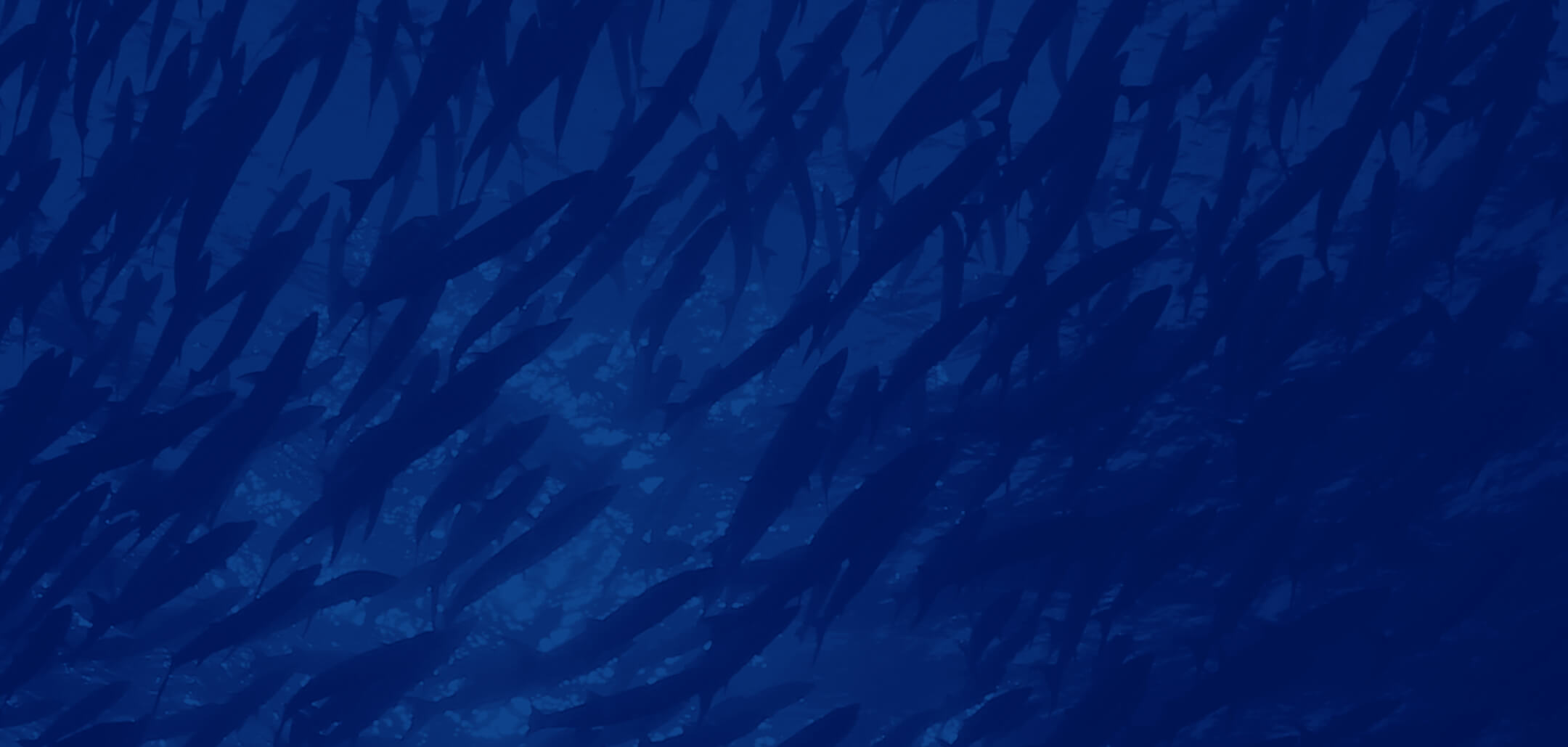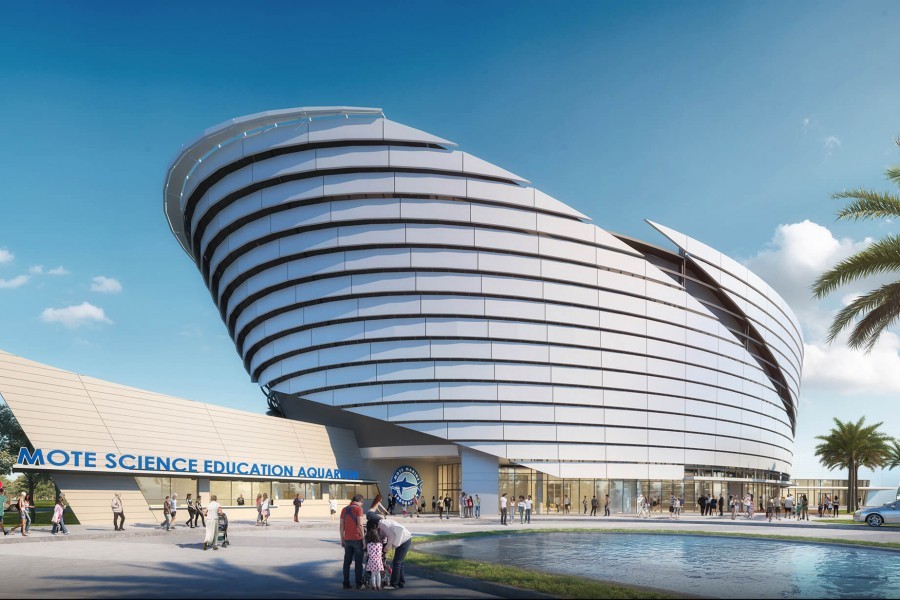This story is a highlight from our 2020 Annual Report.
It’s been the talk of the town for some time in southwest Florida: Mote Marine Laboratory & Aquarium is expanding. However, many have only seen part of the picture——plans for our exciting Aquarium rebirth—and have yet to discover the vast upwelling of
science driving Mote’s growth as a global powerhouse of marine research and innovation.
Mote’s Beyond 2020 Vision & Strategic Plan emphasizes expanding our research infrastructure and helping more collaborators from around the world access it. What does that mean and why does it matter?
Let’s start with the new Aquarium and then dive into the science beneath.
THE SEA CHANGE HAS BEGUN
This summer, Mote President & CEO Dr. Michael P. Crosby announced that approximately $75 million has been raised for the rebirth of Mote Aquarium as Mote Science Education Aquarium (Mote SEA)—more than half the $130-million goal in Mote’s Oceans for All campaign to create this iconic, 110,000-square-foot facility. Mote SEA, planned for Nathan Benderson Park, is projected to inspire 700,000 visitors from the Sarasota-Manatee region and around the world each year with incredible displays of marine life, interactive technology and windows into Mote’s amazing science. Mote SEA will enhance Florida tourism and economies, create jobs and inspire the next generation of marine scientists with its three state-of-the-art STEM teaching labs offering no-cost programming for Sarasota and Manatee county school districts. On Nov. 13, 2020, Crosby joined Mote Trustees, donors, and federal, state and local leaders in the groundbreaking ceremony for Mote SEA—the most exciting step yet toward its projected opening in 2023.
BENEATH THE SEA
The rebirth of Mote Aquarium in a new home will meet a critical need: clearing space for more science— the type of large-scale, multi-partner science and innovation needed to address the grand challenges facing our oceans and communities. That’s why Mote is planning to add or renovate 60,000 square feet at its primary research campus on City Island, Sarasota, to create an International Marine Science, Technology & Innovation Park—beginning when the current Aquarium space is freed. This transformation will give Mote scientists, engineers, visiting researchers, and science and technology entrepreneurs from around the globe the expanded, state-of-the-art facilities they need to restore and conserve our oceans, build a “blue economy,” and enable both to thrive and benefit our communities for generations.
SCIENCE AND CONSERVATION CANNOT WAIT
While the two major goals above are prioritized in Mote’s Beyond 2020 Vision, other exciting expansions are already here, helping to answer the ocean’s call now.
At Mote Aquaculture Research Park, Inland Sarasota County
- Florida Red Tide Mitigation & Technology Development Facility
To fight the impacts of Florida red tide (blooms of Karenia brevis algae) effectively while causing no further environmental harm than red tide itself, scientists must test red tide mitigation compounds and technologies in the environment. Long before that, they must test them in the lab and then in large “mesocosm” or “raceway” tanks designed to provide a preview of the possible environmental impacts. This year, Mote created a cutting-edge facility to do just that, as part of the Florida Red Tide Mitigation & Technology Development Initiative led by Mote in partnership with the Florida Fish and Wildlife Conservation Commission (FWC). The facility, occupying 28,800 square feet of Mote’s existing campus space, can hold almost 150,000 gallons of treated and recirculated seawater. Its six labs include a culture room for growing algae, a chemistry lab, and large systems of long tanks called raceways and 5- or 10-foot mesocosms where scientists can create mini versions of Sarasota Bay, the Gulf of Mexico or other relevant environments by maintaining shellfish, seaweed, sponges, sediments and other ecosystem components that could be sensitive to mitigation efforts. Use of the facility and its unprecedented quantities of Karenia brevis culture are free for scientists from around the world whose projects are part of the Initiative.
- Mote’s International Coral Gene Bank
Coral reefs are experiencing unprecedented die-offs worldwide, and it’s critical to restore them with resilient and genetically diverse corals that have the best chances to survive and reproduce. However, scientists can only do that if our native corals don’t disappear first. To protect the living treasure of coral genetic diversity, Mote has created a unique, large-scale, land-based, living coral gene bank where dozens of coral genotypes (genetic varieties) of at least 30 species can be stored in triplicate. Mote’s International Coral Gene Bank, created during 2020-2021, is housed in Category 5 hurricane-resistant infrastructure and contains four separate life-support systems, so if one system fails, corals supported by other systems will be preserved. In early 2021, Mote scientists began introducing corals into some of the Gene Bank’s four systems, which have room for up to 500 mature parent corals or 15,000 small coral fragments. The facility provides precision control of temperature, chemistry, water level, lighting and more, to keep the corals happy and healthy. Mote’s Gene Bank will also help produce new coral offspring through its dedicated laboratory for controlled, yearround, coral sexual reproduction—a key step to infuse fresh genetic diversity into the science-based coral reef restoration Mote is spearheading. With over 1,600 genotypes, Mote has one of the largest single collections of living coral genetic diversity in existence. Our gene bank vision began with a focus on corals endemic to Florida and U.S. jurisdictions of the Caribbean, and it is now expanding to include coral genetic diversity from reefs around world.
In the Florida Keys
- Powering coral restoration in Islamorada
This year, Mote was honored to establish a partnership with the famed Bud n’ Mary’s Marina to bring the first science-based coral nursery for restoration to Islamorada in the Upper Florida Keys. The facility will fill a critical gap in reef restoration coverage—allowing Mote to target restoration sites at Cheeca Rocks, one of seven reef areas prioritized for concentrated, collective restoration in Mission Iconic Reefs, a partnership overseen by the National Oceanic and Atmospheric Administration that includes Mote and complements Mote’s own major restoration strategy. Islamorada Conservation and Restoration Education (I.Care) will work with citizen divers to help outplant and monitor Mote-supplied coral fragments onto Islamorada’s reefs.


